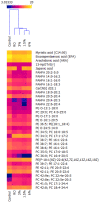Analysis of Muscle Lipidome in Juvenile Rainbow Trout Fed Rapeseed Oil and Cochayuyo Meal
- PMID: 35740930
- PMCID: PMC9221170
- DOI: 10.3390/biom12060805
Analysis of Muscle Lipidome in Juvenile Rainbow Trout Fed Rapeseed Oil and Cochayuyo Meal
Abstract
This study aimed to analyze the effects on the lipidome of juvenile Oncorhynchus mykiss muscle fed 90% Brassica napus "rapeseed" oil and different amounts of Durvillaea antarctica "Cochayuyo" meal (1.5, 3 and 6%) as a replacement for cellulose. The analysis allowed for the identification of 329 lipids, mainly represented by phospholipids and fatty esters. The inclusion of Brassica napus oil significantly increased the levels of C18:2 species and fatty esters of hydroxylated fatty acids, which could play a bioactive role in human health. One of the most abundant lipids in all fillets was Phosphatidylcholine 33:6, which, according to the literature, could be considered a biomarker for the identification of Oncorhynchus mykiss. In all experimental diets, the species Phosphatidylethanolamine 15:1-18:24 showed four-fold higher levels than the control; increments of n-3- and n-6-rich phospholipids were also observed. Diets containing Durvillaea antarctica meal did not generate more significant variation in fish muscle phospholipids relative to the muscle of the rapeseed-oil-only group. These lipid species consist of medium- and long-chain fatty acids with different degrees of unsaturation. Still, it appears that the rapeseed oil masks the lipid contribution of the meal, possibly due to the low levels of total lipids in the macroalgae.
Keywords: LC-MS/MS; aquaculture; metabolomics; phospholipids; seaweed; sustainability.
Conflict of interest statement
The authors declare no conflict of interest.
Figures


Similar articles
-
Fatty acid utilisation and metabolism in caecal enterocytes of rainbow trout (Oncorhynchus mykiss) fed dietary fish or copepod oil.Biochim Biophys Acta. 2005 Dec 15;1737(2-3):119-29. doi: 10.1016/j.bbalip.2005.09.008. Epub 2005 Oct 5. Biochim Biophys Acta. 2005. PMID: 16257262
-
Effects of dietary cholesterol supplementation on growth and cholesterol metabolism of rainbow trout (Oncorhynchus mykiss) fed diets with cottonseed meal or rapeseed meal.Fish Physiol Biochem. 2014 Dec;40(6):1827-38. doi: 10.1007/s10695-014-9971-2. Epub 2014 Aug 15. Fish Physiol Biochem. 2014. PMID: 25119853 Clinical Trial.
-
Dietary low-glucosinolate rapeseed meal affects thyroid status and nutrient utilization in rainbow trout (Oncorhynchus mykiss).Br J Nutr. 2000 Jun;83(6):653-64. doi: 10.1017/s0007114500000830. Br J Nutr. 2000. PMID: 10911774
-
Dietary fish oil and digestible protein modify susceptibility to lipid peroxidation in the muscle of rainbow trout (Oncorhynchus mykiss) and sea bass (Dicentrarchus labrax).Br J Nutr. 1998 Sep;80(3):281-9. Br J Nutr. 1998. PMID: 9875068
-
Dietary Buglossoides arvensis Oil as a Potential Candidate to Substitute Fish Oil in Rainbow Trout Diets.Lipids. 2018 Aug;53(8):809-823. doi: 10.1002/lipd.12092. Epub 2018 Oct 17. Lipids. 2018. PMID: 30334262
Cited by
-
CRL2LRRC41-Mediated DDX5 Ubiquitination Enhances Interaction with ELAVL1 Preventing NOG mRNA Degradation and Sustaining Proliferation and Migration of Human Spermatogonial Stem Cell-Like Cell Line.BMC Biol. 2025 Aug 7;23(1):247. doi: 10.1186/s12915-025-02363-z. BMC Biol. 2025. PMID: 40775760 Free PMC article.
References
-
- Food and Agriculture Organization . The State of World Fisheries and Aquaculture 2018—Meeting the Sustainable Development Goals. Fisheries and Aquaculture Department; Rome, Italy: 2018.
-
- Liu Z.-L., Zhao W., Hu W.-S., Zhu B., Xie J.-J., Liu Y.-J., Tian L.-X., Niu J. Lipid metabolism, growth performance, antioxidant ability and intestinal morphology of rainbow trout (Oncorhynchus mykiss) under cage culture with flowing water were affected by dietary lipid levels. Aquac. Rep. 2021;19:100593. doi: 10.1016/j.aqrep.2021.100593. - DOI
Publication types
MeSH terms
Substances
LinkOut - more resources
Full Text Sources

